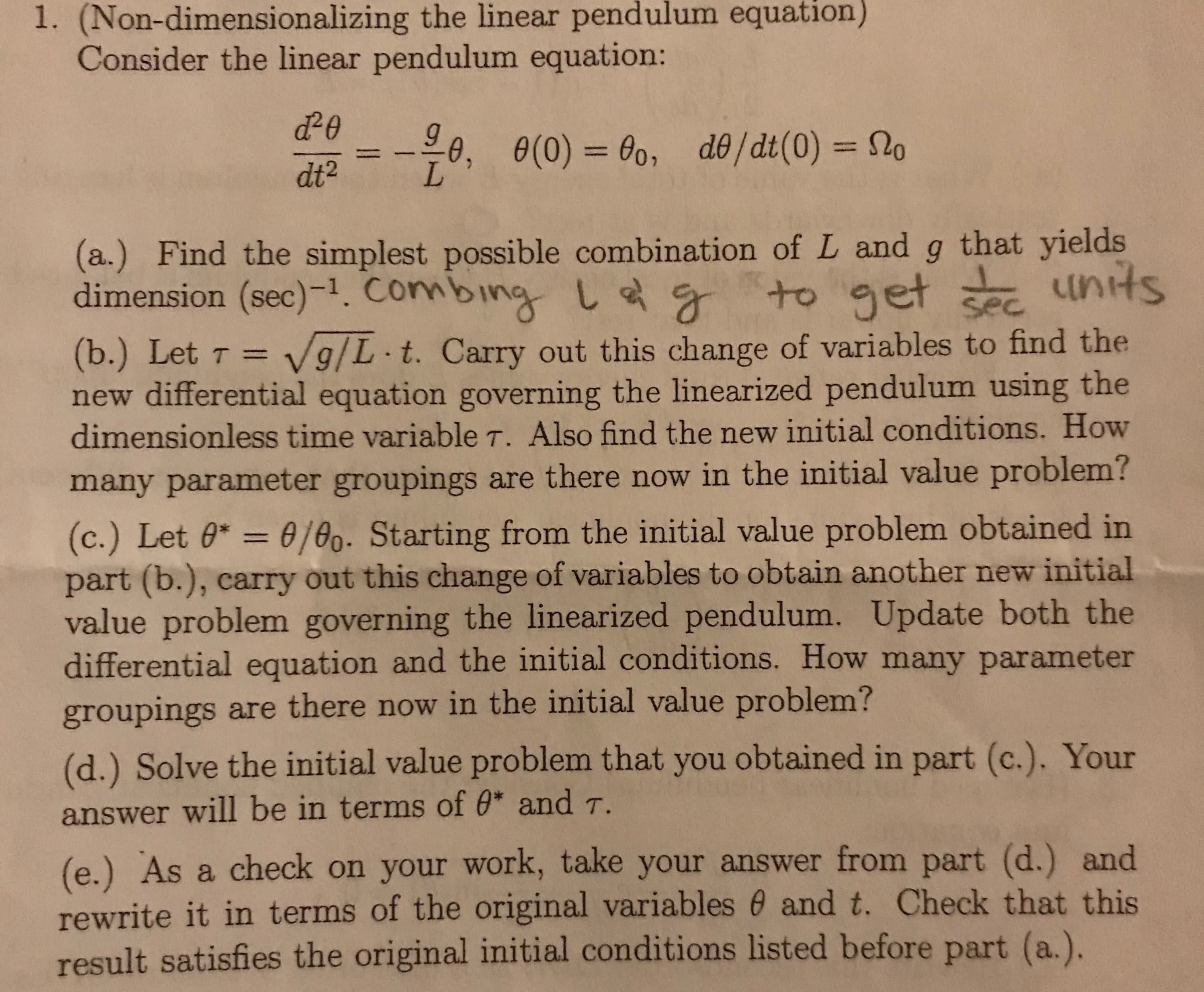1. (Non-dimensionalizing the linear pendulum equation Consider the linear pendulum equation: e(0)= 00, de /dt (0) = 2o L dt2 (a.) Find the simplest possible combination of L and g that yields dimension (sec)-1. Connbing L to get units Sec (b.) Let T new differential equation governing the linearized pendulum using the dimensionless time variable T. Also find the new initial conditions. How V9/L t. Carry out this change of variables to find the many parameter groupings are there now in the initial value problem? (c.) Let 0* = 0/00. Starting from the initial value problem obtained in part (b.), carry out this change of variables to obtain another new initial value problem governing the linearized pendulum. Update both the differential equation and the initial conditions. How many parameter groupings are there now in the initial value problem? (d.) Solve the initial value problem that you obtained in part (c.). Your answer will be in terms of 0* and T. (e.) As a check on your work, take your answer from part (d.) and rewrite it in terms of the original variables 0 and t. Check that this result satisfies the original initial conditions listed before part (a.).
1. (Non-dimensionalizing the linear pendulum equation Consider the linear pendulum equation: e(0)= 00, de /dt (0) = 2o L dt2 (a.) Find the simplest possible combination of L and g that yields dimension (sec)-1. Connbing L to get units Sec (b.) Let T new differential equation governing the linearized pendulum using the dimensionless time variable T. Also find the new initial conditions. How V9/L t. Carry out this change of variables to find the many parameter groupings are there now in the initial value problem? (c.) Let 0* = 0/00. Starting from the initial value problem obtained in part (b.), carry out this change of variables to obtain another new initial value problem governing the linearized pendulum. Update both the differential equation and the initial conditions. How many parameter groupings are there now in the initial value problem? (d.) Solve the initial value problem that you obtained in part (c.). Your answer will be in terms of 0* and T. (e.) As a check on your work, take your answer from part (d.) and rewrite it in terms of the original variables 0 and t. Check that this result satisfies the original initial conditions listed before part (a.).
Related questions
Question
pleas ehelp me answer these questions.
a,b,c,d,and e.
thank you!

Transcribed Image Text:1. (Non-dimensionalizing the linear pendulum equation
Consider the linear pendulum equation:
e(0)= 00, de /dt (0) = 2o
L
dt2
(a.) Find the simplest possible combination of L and g that yields
dimension (sec)-1. Connbing L to get
units
Sec
(b.) Let T
new differential equation governing the linearized pendulum using the
dimensionless time variable T. Also find the new initial conditions. How
V9/L t. Carry out this change of variables to find the
many parameter groupings are there now in the initial value problem?
(c.) Let 0* = 0/00. Starting from the initial value problem obtained in
part (b.), carry out this change of variables to obtain another new initial
value problem governing the linearized pendulum. Update both the
differential equation and the initial conditions. How many parameter
groupings are there now in the initial value problem?
(d.) Solve the initial value problem that you obtained in part (c.). Your
answer will be in terms of 0* and T.
(e.) As a check on your work, take your answer from part (d.) and
rewrite it in terms of the original variables 0 and t. Check that this
result satisfies the original initial conditions listed before part (a.).
Expert Solution
This question has been solved!
Explore an expertly crafted, step-by-step solution for a thorough understanding of key concepts.
This is a popular solution!
Trending now
This is a popular solution!
Step by step
Solved in 6 steps with 6 images
